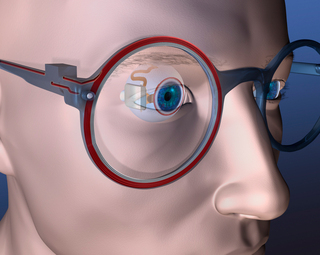Carnegie Mellon senior systems scientist Shawn Kelly is developing a retinal prosthesis capable of restoring vision to those with degenerative eye diseases. He was recently awarded a four-year, $1.1 million grant from the U.S. Department of Veterans Affairs to continue his research.
(..)
The 15 micrometer-thick prosthesis is surgically inserted through a small incision near the back of the eye, and is held in place by the retina. Its communication coil — which allows the chip to “talk” to external devices — is attached to the sclera, or the white of the eye.
“We don’t expect significant discomfort,” Kelly said of the seemingly intrusive implant. “Other ophthalmic devices sit in this area, including scleral buckles to repair retinal detachments, and some glaucoma pressure valves.”
After surgery, a patient would wear a pair of eyeglasses with a camera fitted into its frame. The camera connects to a portable image processor, which wirelessly transfers a compressed version of the captured image data to the implanted device. The prosthesis then sends stimulating signals to the appropriate retinal nerves, creating a pixelated form of the original image.












